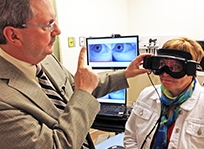AHS clinic offers one-stop care for dizziness
Story and Photo by Greg Harris
Nova Lee Turner knows all too well what can happen when the delicate system in the inner ear malfunctions.
December (2012), after suffering a bout of the flu that affected her inner ear, the Calgary IT professional became so ill that she would become nauseous whenever she moved her eyes. Bedridden, she eventually had to be admitted to Rockyview General Hospital for several days and remained on Gravol for weeks after she was released.
 Today, Turner is back on her feet – without becoming dizzy or nauseous – thanks to a new program at South Health Campus that specializes in disorders of the inner ear. Dr. Bill Fletcher examines patient Nova Lee Turner using some of the specialized equipment available at the ‘Dizzy Clinic,’ located at South Health Campus in Calgary.
Today, Turner is back on her feet – without becoming dizzy or nauseous – thanks to a new program at South Health Campus that specializes in disorders of the inner ear. Dr. Bill Fletcher examines patient Nova Lee Turner using some of the specialized equipment available at the ‘Dizzy Clinic,’ located at South Health Campus in Calgary.
The Neurovestibular Program, known informally as the Dizzy Clinic, was developed by Alberta Health Services (AHS) and the Neurology and Otolaryngology Divisions of the Departments of Clinical Neurosciences and Surgery.
The program features some of the latest diagnostic and rehabilitative technology. Three specialized physicians, a technician and two physiotherapists practise out of the clinic, meaning patients can be tested, diagnosed and treated – all in one location.
In Turner’s case, physiotherapy helped correct her problem, and an ongoing program of specific exercises has helped her continue to improve balance and eye stability.
“When I first came in and was tested, they found that when I moved my head, my eyes did not respond normally due to the inner ear problem,” Turner says. “It’s been such a relief that they were able to figure out relatively quickly what was going on.”
Turner returned to work (last) April and (was soon) well enough to drive.
Open since January (2013), about 35 patients visit the Neurovestibular Program every week. Access is by referral only.
“When patients can see an interdisciplinary team, it helps get them back on their feet faster,” says Dr. Bill Fletcher, a neuro-ophthalmologist who co-directs the program with Dr. Beth Lange, an otolarygologist (ear, nose and throat specialist).
“Research suggests that the longer you take to treat people with neurovestibular issues, the longer their recovery takes.”
The Neurovestibular Program also includes an Urgent Vertigo Clinic for individuals who experience a sensation of whirling and loss of balance.
“Emergency departments now refer patients with acute vertigo symptoms directly to the Urgent Vertigo Clinic,” says Dr. Suresh Subramaniam, who runs the clinic. “This approach helps them to recover more quickly.”
The neurovestibular system is a complex network that includes inner ear structures, nerves, the brain and the eyes, which all work together to help keep us oriented correctly in space. Problems with the neurovestibular system can be caused by infections, head injuries, some medications, aging, migraine and stroke.
Some of the Neurovestibular Program’s state-of-the-art testing equipment includes:
- Videonystagmography (VNG), which records eye movement using goggle-mounted video cameras.
- Caloric testing, which involves irrigating each ear with warm or cool water and then tracking eye movement with the VNG system.
- Rotational testing, which involves sitting in a chair that rotates in darkness while eye movement is recorded with the VNG system.
- Computerized dynamic posturography, which measures balance while standing on a platform surrounded by visual input.
- Evoked responses, which are tiny electrical brain waves or muscle twitches triggered by clicks in the ears and recorded using small detectors over the face and neck.
Patients in the Neurovestibular Program also have access to testing with an audiologist elsewhere in the hospital.


